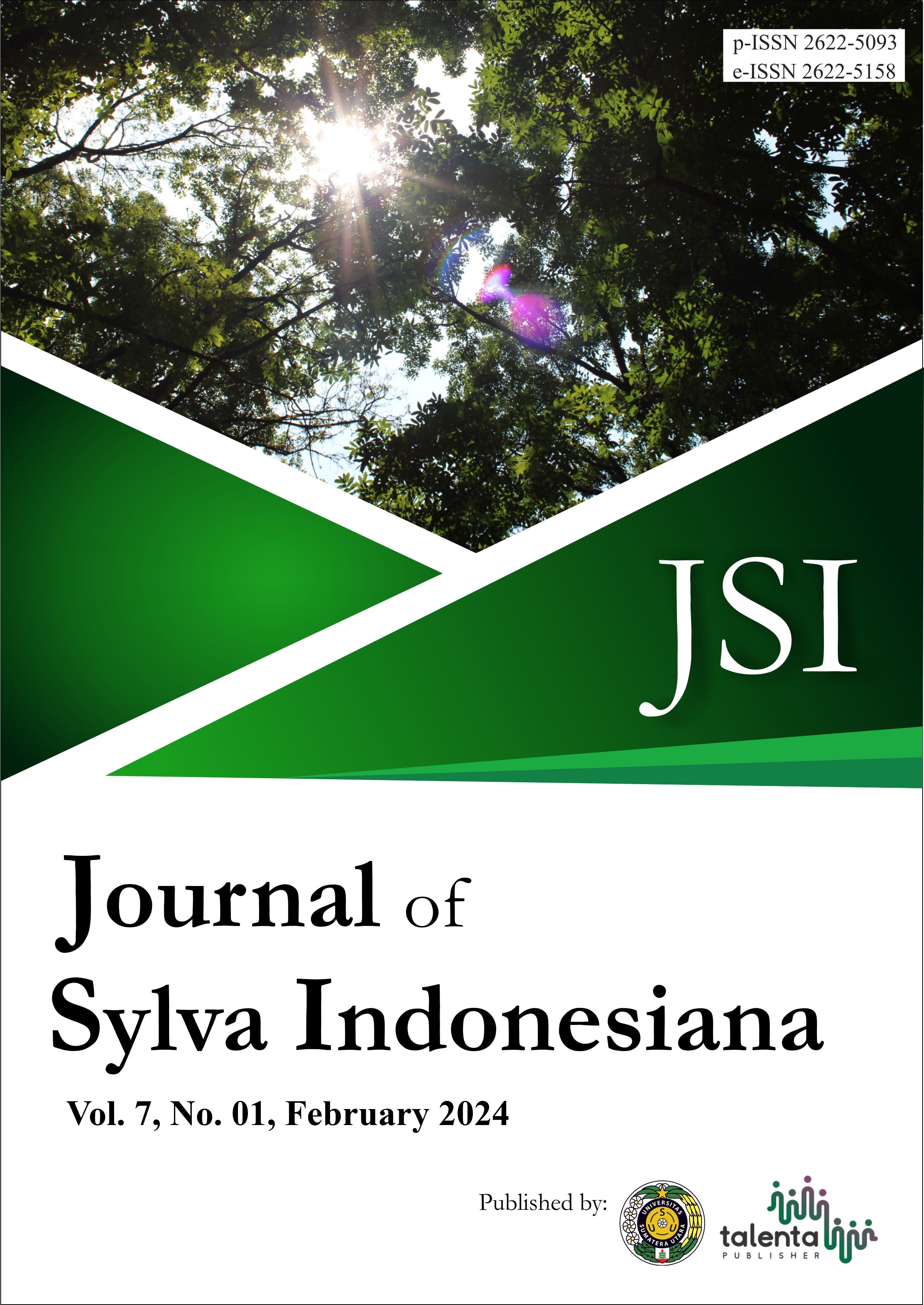Ecotourism Development Strategy of Lhok Batee Jeumpa Reservoir, Bireuen Regency
DOI:
https://doi.org/10.32734/jsi.v7i01.13356Keywords:
Conservation, Ecotourism, Reservoir, Stakeholder, Sustainable, Tourism, Tourist AttractionAbstract
Bireuen Regency has natural tourism that has the potential to be an ecotourism area, namely the Lhok Batee Reservoir, which is located in Seuneubok Lhong Village, Jeumpa District. This study aims to calculate the carrying capacity of tourist areas, analyze stakeholders based on their influence and importance, and formulate ecotourism development strategies at Lhok Batee Reservoir. The research method uses a survey approach through direct observation in the field with interviews with 50 respondents. The results showed that the carrying capacity of the area was 1,008 people per day. The analysis shows that two classifications of stakeholders play a role in the management of the area and the development of reservoir ecotourism, namely bystanders (Marine Fisheries Food Service; Public Works and Spatial Planning Service; Youth, Sports, and Tourism Service; Environmental Observation Group) and players (Village Government; Regional Development Planning Agency; Environment and Forestry Service). The results of the study formulated an ecotourism development strategy at Lhok Batee Reservoir to increase natural resource conservation efforts, develop the potential of natural resources owned by Lhok Batee Reservoir, develop ecotourism activities while maintaining biodiversity, involve the community to play an active role in tourism activities at Lhok Batee Reservoir, and optimize cooperation programs with stakeholders in marketing Lhok Batee Reservoir ecotourism and in providing environmental training
Downloads
References
Directorate of Finance, Information Technology, and Tourism Statistic. Domestic Tourism Statistic 2022. Jakarta: BPS-Statistics Indonesia. 2022. [Online]. Available: BPS – Statistics Indonesia.
S. Maihani, “Potensi Pariwisata Dalam Perspektif Entrepreneurial Govertnmentâ€. Lentera: Jurnal Ilmiah Sains dan Teknologi, 15(13). 146497. 2015
M. Aurel, A. Simina, & S. Titu, “Measuring Service Quality in Tourism Industryâ€. Procedia – Social and Behavioral Sciences, vol 221, 294 – 301. 2016
T. M. Annisa, & R. Harini, “Analisis Kesediaan Membayar (WTP) Untuk Mendukung Ekowisata Berkelanjutan Di Kawasan Wisata Gua Pindul, Kabupaten Gunungkidulâ€, Jurnal Bumi Indonesia, 6(4), 228867. 2017
[TIES] The International Ecotourism Society, What is ecotourism?. 2015. [Online] Available: http://www.ecotourism.org/what-is-ecotourism. [Accessed: Dec. 22, 2022].
F. Yulianda, “Ekowisata Perairan (Suatu Konsep Kesesuaian dan Daya Dukung Bahari dan Wisata Air Tawar)â€. Bogor: IPB Press. 2019.
Undang-Undang Republik Indonesia Nomor 10 Tahun 2009 tentang Kepariwisataan
H. Muntasib, E. Rachmawati, R. Meilani, A. Mardiastuti, SB. Rushayati, A. Sunkar, N. Kosmaryandi, “Rekreasi alam dan ekowisataâ€, Bogor: IPB Press. 2014. [Online] Available: ipbpress.com
Badan Pusat Statistik Kabupaten Bireuen, “Kabupaten Bireuen dalam Angkaâ€, 2022. [Online]. Available: https://bireuenkab.bps.go.id/. [Accessed: March. 20, 2023].
A. Pangemanan, Maryunan, H. Luchman, and P. Bobby, “Economic Analysis of Bunaken Nasional Park Ecotourism Area Based on the Carrying Capacity and Visitation Levelâ€, Asian Transaction on Basic and Applied Sciences. 2(4):34-40. 2012
H. Widiyanti, “Strategi Tata Kelola Pengembangan Ekowisata Di Taman Wisata Alam Kawah Ijen Propinsi Jawa Timurâ€, M. Si. Thesis, Pascasarjana Institut Pertanian Bogor. Bogor. 2016.
Reed, S.M. Graves, A. Dandy, N. Posthumus, H. Hubacek, K. Morris, J. Prell, C. Quinn, H.C. Stringer, L.C, “Who’s in and why? a typology of stakeholder analysis methods for natural resource managementâ€, Journal of Environmental Management, 90: 1993-1949. 2009
B. Phadermrod, R.M. Crowder, G.B. Wilss, “Importance-performance analysis based SWOT analysisâ€, International Journal of Information Management, 44 : 193 – 203. 2019.
E. Setyawan, F. Muhammad, B. Yulianto, “Kesesuaian dan daya dukung kawasan untuk ekowisata mangrove di Pasarbanggi Kabupaten Rembang, Jawa Tengahâ€, Ekosains, 7(3): 47-54. 2015
I. Nugroho, Pengembangan desa melalui ekowisata. Solo: Era Edicitra Intermedia, 2015. [Online] Available: Researchgate.
S. Siahaan, R. S. Wulandari and R. M. Astrida, “The Carrying Capacity of Nature Tourism in Salapar Hill, Bengkayang Regency, Indonesiaâ€, Journal of Sylva Indonesiana, 6(01), 79-91. 2023
M. L. Widodo, R. Soekmadi and H. S. Arifin, “Analisis stakeholders dalam pengembangan ekowisata di taman nasional Betung Kerihun Kabupaten Kapuas Huluâ€, Journal of Natural Resources and Environmental Management, 8(1), 55-61. 2018.
Y. T. Latupapua, “Implementasi peran stakeholder dalam pengembangan ekowisata di Taman Nasional Manusel (TNM) di Kabupaten Maluku Tengahâ€, Jurnal Agroforestri. 10(1): 21-30. 2015.
F. Rangkuti, Analisis SWOT: Teknik Membedah Kasus Bisnis. Jakarta: Gramedia Pustaka Utama, 2015. [Online] Available: library.unismuh.ac.id.
Rini, “Strategi pengembangan ekowisata mangrove dengan pendekatan kapasitas adaptif di Lantebung Kota Makassarâ€, M. Si. Thesis, Pascasarjana Institut Pertanian Bogor. Bogor. 2018.
M. Pattiwael, “Konsep pengembangan ekowisata berbasis konservasi di Kampung Malagufuk Kabupaten Sorongâ€, Journal of Dedication to Papua Community, 1(1), 42-54. 2018.
I. O. Eman, B. A. B. Sagay, & S. G. Jocom, “Strategi Pengembangan Objek Wisata Danau Linouw Terhadap Peningkatan Pendapatan Asli Daerah (PAD) Kota Tomohonâ€, Agri – Sosioekonomi, 14(1), 371-388. 2018.
D. P. Maesti, D. N. Utami, M. S. Zuhdi, R. Pratiwi, S. Samsi, & V. Cecilia, “Pengembangan Objek dan Daya Tarik Wisata Sungai Ciliwung Berbasis Ekowisataâ€, Jurnal Inovasi Penelitian, 3(6), 6621-6632. 2022.
A. R. Bagasta, C. Iswara & A. Lasally, “Analisis Potensi Wisata Menggunakan Informasi Geografis dan Strategi Pengembangan Pariwisata Berkelanjutan Berbasis Masyarakat di Desa Sumberagung, Grobogan, Jawa Tengahâ€, Jurnal Kepariwisataan Indonesia: Jurnal Penelitian dan Pengembangan Kepariwisataan Indonesia, 15(2), 148-157. 2021.
I. M. S. Amerta, “The Role of Tourism Stakeholders at Jasri Tourism Village Development, Karangasem Regencyâ€, International Journal of Social Sciences and Humanities, 1 (2), 20–28. 2017.
S. Ghoddousi, P. Pintassilgo, J. Mendes, A. Ghoddousi & B. Sequeira, “Tourism and nature conservation: A case study in Golestan National Park, Iranâ€. Tourism management perspectives, 26, 20-27. 2018.
D. D. Fundeanu, “Innovative regional cluster, model of tourism developmentâ€, Procedia Economics and Finance, 23, 744-749. 2015.

Downloads
Published
How to Cite
Issue
Section
License

This work is licensed under a Creative Commons Attribution-ShareAlike 4.0 International License.


















